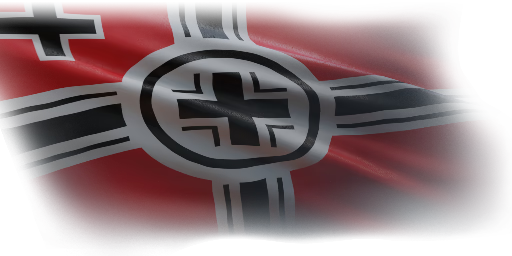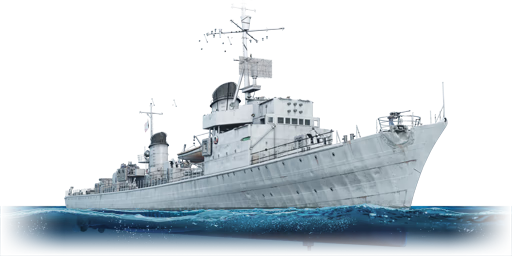



The T22 was a German torpedo boat built for the Kriegsmarine in the 1940s. She was laid down in 1941 and commissioned on 28th February 1942. The Type 1939 torpedo boats, as the ships were referred to, nearly matched the size of the Type 1936 destroyers, although they were not supposed to be ocean-going and also carried lighter armament. The T22 was built with four 10.5 cm SK C/32 cannons with 100 rounds per gun. Anti-aircraft protection was made up of two twin 3.7 cm SK C/30 cannons and five 2 cm C/38 single mounted autocannons as well as single 2 cm Flakvierling 38 quadruple mount. T22 as a torpedo boat was armed with two triple 533 mm launchers located amidships and firing G7a torpedoes.
After her commissioning, T22 conducted escort duties in the Channel and in the Bay of Biscay. On 22nd October 1943, T22 together with her sisters T23, T25, T26 and T27 sortied from Brest to rendezvous with blockade runner Münsterland and her escort. The Royal Navy was aware of Münsterland, and sent Dido-class cruiser HMS Charybdis as well as four Hunt-class destroyers, one U-class destroyer, and one R-class destroyer to intercept the blockade runner. British ships were unable to find the Germans, and German torpedo boats fired their torpedoes, two of which struck the HMS Charybdis and sunk her. One of the torpedoes fired by T22 blew off the bow of Hunt-class destroyer HMS Limbourne, which was later scuttled. On 27th December 1943, T22 and her sisters reinforced by Z23 and Z25 set sail to meet with blockade runner Alsterufer, which unknown to the Germans had been sunk that day by a Czechoslovak 311th Bomber Squadron B-24 Liberator bomber. Two British light cruisers were sent to intercept the destroyers, Town-class light cruiser HMS Glasgow and Emerald-class light cruiser HMS Enterprise. German forces decided to split, with Z23, Z27, T22, T25, and T26 to reverse course north. Enterprise crippled Z27 while Glasgow crippled T25 and T26. T22 approached T25 in order to embark her crew and fired all of her torpedoes on Glasgow in an attempt to drive the cruiser off but all missed. T22 and Z23 later returned to French port of Saint-Jean-De-Luz near Spanish border. On 18th August 1944, T22, T30, and T32 sortied from Helsinki, tasked with laying minefields in Narva Bay. Shortly after they started to lay mines, T30 was struck by a mine, losing her power. A minute later, T32 struck another mine that blew off her bow, disabling her engines. Five minutes later, T30 exploded and broke in half after hitting another mine. While trying to get alongside T32, the T22 struck a mine and exploded with a loss of 143.
The T22 was introduced in Update 1.79 "Project X" as part of the fleet closed beta test. Unlike the Leopard or other German destroyers, the T22 is armed with only 10.5 cm cannons as opposed to the 12.8 cm found on Leopard and later Type 1936 destroyers. As with nearly all destroyers placed early in the tech tree, the anti-air protection is not adequate and often the gunners start engaging targets after they have already dropped their ordnance. Torpedo armament on the other hand is very effective with the G7a torpedoes being one of the best a captain can come across in War Thunder. The T22 does not have any armour protection and her magazines are located above waterline, entirely unprotected, making them susceptible to fatal explosion.
| Ammunition | Type | Armor penetration (mm) at a distance: | |||||
|---|---|---|---|---|---|---|---|
| 1000 m | 2500 m | 5000 m | 7500 m | 10000 m | 15000 m | ||
| HE | 20 | 20 | 20 | 20 | 20 | 20 | |
| HE | 41 | 32 | 21 | 20 | 20 | 20 | |
| HE-TF | 20 | 20 | 20 | 20 | 20 | 20 | |
| Belt | Belt filling | Armor penetration (mm) at a distance: | |||||
|---|---|---|---|---|---|---|---|
| 10 m | 100 m | 500 m | 1000 m | 1500 m | 2000 m | ||
| AP-T/AP/HEF-T/HEF | 36 | 35 | 29 | 24 | 21 | 18 | |
| AP/AP-T/AP/HEF | 36 | 35 | 29 | 24 | 21 | 18 | |
| HEF/HEF-T/HEF/AP | 36 | 35 | 29 | 24 | 21 | 18 | |
| Belt | Belt filling | Armor penetration (mm) at a distance: | |||||
|---|---|---|---|---|---|---|---|
| 10 m | 100 m | 500 m | 1000 m | 1500 m | 2000 m | ||
| AP-T/AP/HEF-T/HEF | 36 | 35 | 29 | 24 | 21 | 18 | |
| AP/AP-T/AP/HEF | 36 | 35 | 29 | 24 | 21 | 18 | |
| HEF/HEF-T/HEF/AP | 36 | 35 | 29 | 24 | 21 | 18 | |
| Ammunition | Type | Armor penetration (mm) at a distance: | |||||
|---|---|---|---|---|---|---|---|
| 10 m | 100 m | 500 m | 1000 m | 1500 m | 2000 m | ||
| HE | 7 | 7 | 6 | 5 | 5 | 5 | |
2 × WBG depth charge











Seakeeping |
|---|
Unsinkability | |
|---|---|
Firepower | ||
|---|---|---|